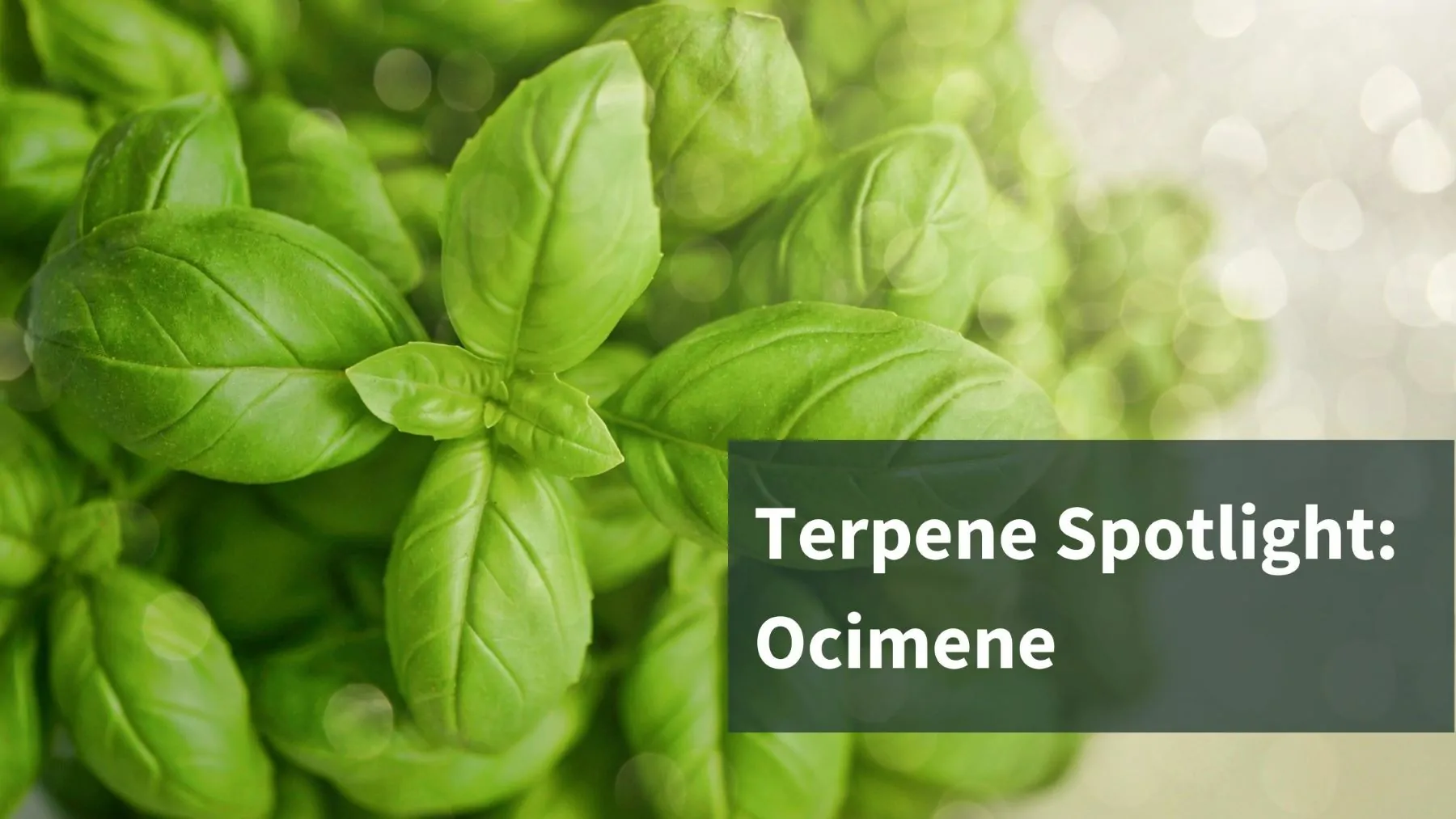No products in the cart.
Terpene Spotlight: Ocimene

Hemp is a mind-bending plant when you think about it. Not only does hemp flower produce over 100 compounds called cannabinoids, but it also produces hundreds of different organic compounds called terpenes. Today, we’ll be looking at one that lends itself to some very delicious herbs: Ocimene.
In the rest of this post, we’ll cover,
- What Ocimene is
- Where you can find it in nature
- Ocimene’s potential benefits
What Are Terpenes?
Terpenes are a diverse grouping of organic compounds primarily responsible for the aroma of many plants. Terpenes also play a crucial role in a plant’s self-defense by deterring pests and herbivores, while simultaneously attracting pollinators.1 In hemp, terpenes give the flowers a bitter taste which deters deer and other would-be crop eaters.
The cosmetic and food industries covet terpenes for their aroma and taste. If you open your fridge right now, you’ll likely find something that contains some form of terpene. Terpenes you’ve likely encountered include:
- Citrus fruits that contain limonene
- Black pepper and rosemary contain beta-caryophyllene
- Beer contains high levels of humulene
What Is Ocimene?
Ocimene is a naturally occurring monoterpene found in a variety of plants, though it derives its name from the word “ṓkimon,” the Greek word for Basil.
There are three different forms of ocimene found in nature: alpha-, cis-beta-, and trans-beta; all found at relatively similar levels in nature.
You’ll find ocimene in many different plants like basil, parsley, mint, kumquats, and, of course, hemp. In a way, Mediterranean cooking owes a lot to this terpene. Its earthy and herbaceous aroma profile lends itself to many regional dishes.
Fun fact: The plant genus name Ocimum also derives its name from “ṓkimon.” Many of the plants inside contain some level of ocimene.
What Is Ocimene Used For?
Outside of the kitchen, we already use ocimene for quite a few things. In cannabis products, it’s thought to have uplifting effects on users.
Cleaning agent
While ocimene doesn’t boast any cleaning abilities, it is often added to cleaning products as an aromatic agent as we humans find its scent quite pleasant. You can find ocimene added to deodorants, hard-surface cleaners, and even laundry detergents.
Insect Repellant
Some studies suggest that ocimene may act as a natural insect repellent and in some cases an insect inhibitor, meaning that it may be able to stunt the development of insect aphids.2
If true, these findings could be a huge breakthrough for organic and no-spray farmers.
Ocimene’s Potential Benefits
Outside of the kitchen, the house, the garden, and IN the lab, ocimene may have some pretty fantastic benefits that we have yet to fully understand. Below is a non-exhaustive list of potential benefits that it may have.
Anti-fungal
A 2015 study published in the Journal of Natural Medicines found that when combined with alpha-pinene, ocimene was a powerful anti-yeast and anti-fungal agent.3
Anti-inflammatory
A 2013 study published in the Food and Chemical Toxicology journal noted that ocimene may have strong anti-inflammatory properties.4 This study, like the study above, did not observe ocimene on its own. Ratherit was part of a larger blend of essential oils from the Water Hemlock (Oenanthe crocata L.) plant.
Anti-viral
A 2008 study published in a Chemistry & Biodiversity report studied and analyzed several Lebanese tree species and their essential oils.5 Ocimene, working together with other terpenes, was found to have inhibitory effects against the herpes simplex virus and a SARS-CoV virus (not COVID-19)
Sunset Lake CBD Cultivars Featuring Ocimene
At Sunset Lake CBD, we pride ourselves on our approach to sungrown hemp. Not only do we think that producing hemp flower outdoors is better for the environment, but it’s also been shown to increase terpene production in the flowers. This year we’ve got a handful of cultivars that prominently feature ocimene including,
- Suver Haze – 0.0256% Ocimene
- Lifter – 0.0229%
- Sour Lifter – 0.0212%
We report terpene content based on dry weight of the flowers.
Sources:
- Divekar, Pratap Adinath et al. “Plant Secondary Metabolites as Defense Tools against Herbivores for Sustainable Crop Protection.” International journal of molecular sciences vol. 23,5 2690. 28 Feb. 2022, doi:10.3390/ijms23052690
- Kang, Zhi-Wei et al. “Volatile β-Ocimene Can Regulate Developmental Performance of Peach Aphid Myzus persicae Through Activation of Defense Responses in Chinese Cabbage Brassica pekinensis.” Frontiers in plant science vol. 9 708. 28 May. 2018, doi:10.3389/fpls.2018.00708
- Cavaleiro, Carlos et al. “Antifungal activity of the essential oil of Angelica major against Candida, Cryptococcus, Aspergillus and dermatophyte species.” Journal of natural medicines vol. 69,2 (2015): 241-8. doi:10.1007/s11418-014-0884-2
- Valente, J et al. “Antifungal, antioxidant and anti-inflammatory activities of Oenanthe crocata L. essential oil.” Food and chemical toxicology : an international journal published for the British Industrial Biological Research Association vol. 62 (2013): 349-54. doi:10.1016/j.fct.2013.08.083
- Loizzo, Monica R et al. “Phytochemical analysis and in vitro antiviral activities of the essential oils of seven Lebanon species.” Chemistry & biodiversity vol. 5,3 (2008): 461-70. doi:10.1002/cbdv.200890045
